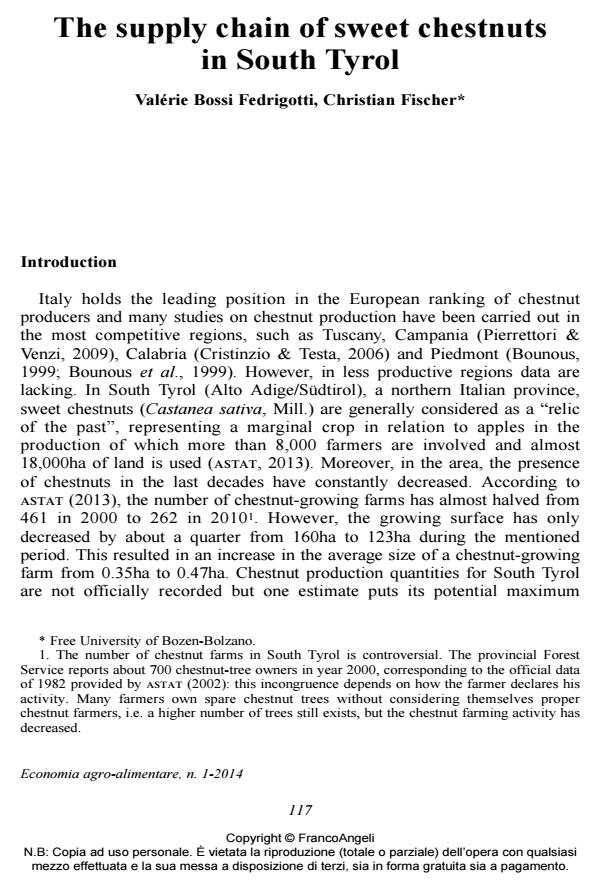The supply chain of sweet chestnuts in South Tyrol
Journal title ECONOMIA AGRO-ALIMENTARE
Author/s Valérie Bossi Fedrigotti, Christian Fischer
Publishing Year 2014 Issue 2014/1
Language Italian Pages 21 P. 117-137 File size 281 KB
DOI 10.3280/ECAG2014-001006
DOI is like a bar code for intellectual property: to have more infomation
click here
Below, you can see the article first page
If you want to buy this article in PDF format, you can do it, following the instructions to buy download credits

FrancoAngeli is member of Publishers International Linking Association, Inc (PILA), a not-for-profit association which run the CrossRef service enabling links to and from online scholarly content.
Italy is the largest producer of chestnuts in Europe and its most advanced and chestnut-oriented regions are Tuscany, Calabria, Campania and Piedmont. This study, however, focuses on the chestnut supply chain in South Tyrol (Alto Adige/Südtirol), a northern province where chestnuts are currently of minor importance in relation to other crops, such as apples and grapes. Nevertheless, a small number of chestnut farmers still keep the historically-rooted tradition alive. A detailed survey of the chestnut supply chain, involving interviews with 138 producers, 49 distributors and 272 consumers revealed the strengths and weaknesses of the local niche market. Moreover, separate analysis of four sub-regions revealed that significant production and marketing heterogeneity exists. In orchard management, as well as in purchasing and consumption habits, three different local characteristics were identified: (i) around Merano commercial chestnut production and direct sales; (ii) around Bressanone chestnut wood production; and (iii) in the Valle Isarco the use of "chestnut trails" as spare time activities. New regional development strategies will therefore have to take into account geographical disparities when introducing innovations into this traditional agricultural activity.
Keywords: Chestnuts, market, supply chain, South Tyrol
Jel codes: Q13
- Public Preferences for Farmed Landscapes: the Case of Traditional Chestnut Orchards in South Tyrol Valérie Bossi Fedrigotti, Stefania Troiano, Christian Fischer, Francesco Marangon, in European Countryside /2020 pp.99
DOI: 10.2478/euco-2020-0006
Valérie Bossi Fedrigotti, Christian Fischer, The supply chain of sweet chestnuts in South Tyrol in "ECONOMIA AGRO-ALIMENTARE" 1/2014, pp 117-137, DOI: 10.3280/ECAG2014-001006